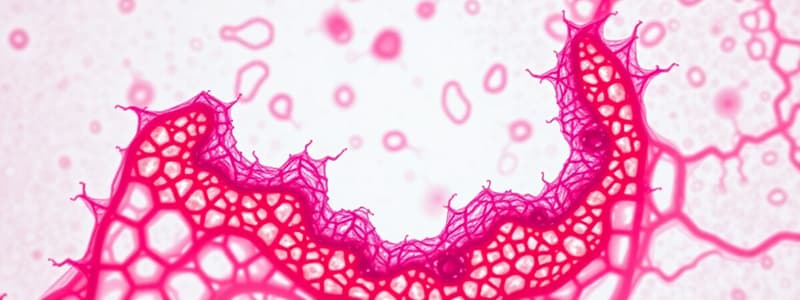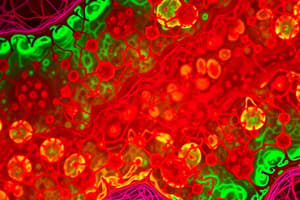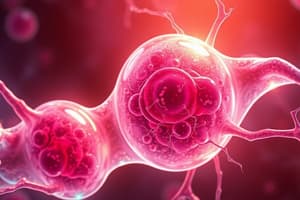Podcast
Questions and Answers
Which of the following is the MOST accurate description of epithelial-mesenchymal transition (EMT)?
Which of the following is the MOST accurate description of epithelial-mesenchymal transition (EMT)?
- The process that maintains the structural integrity of epithelial tissues during development.
- The process of programmed cell death in epithelial tissues.
- The process by which cells increase their adhesion to neighboring cells.
- The process where polarized epithelial cells transform into cells with mesenchymal characteristics. (correct)
During EMT, which of the following molecular changes is typically observed in cells undergoing this transition?
During EMT, which of the following molecular changes is typically observed in cells undergoing this transition?
- Upregulation of E-cadherin expression.
- Increased expression of epithelial-specific markers and decreased expression of mesenchymal markers.
- Downregulation of vimentin expression.
- Downregulation of E-cadherin and upregulation of vimentin. (correct)
Which type of EMT is MOST closely associated with the processes of wound healing, tissue regeneration, and organ fibrosis?
Which type of EMT is MOST closely associated with the processes of wound healing, tissue regeneration, and organ fibrosis?
- Type 1 EMT
- Type 2 EMT (correct)
- Type 3 EMT
- Type 0 EMT
In the context of cancer progression, what role does EMT play in metastasis?
In the context of cancer progression, what role does EMT play in metastasis?
Which signaling pathway, when activated, leads to the accumulation of β-catenin in the cytoplasm and subsequent translocation to the nucleus, promoting the transcription of EMT-inducing transcription factors?
Which signaling pathway, when activated, leads to the accumulation of β-catenin in the cytoplasm and subsequent translocation to the nucleus, promoting the transcription of EMT-inducing transcription factors?
Why is EMT considered a promising therapeutic target in cancer treatment?
Why is EMT considered a promising therapeutic target in cancer treatment?
How does EMT contribute to drug resistance in cancer cells?
How does EMT contribute to drug resistance in cancer cells?
How does EMT contribute to immune evasion in cancer cells?
How does EMT contribute to immune evasion in cancer cells?
What is the role of EMT in the pathogenesis of organ fibrosis?
What is the role of EMT in the pathogenesis of organ fibrosis?
How does EMT relate to stemness in cancer cells?
How does EMT relate to stemness in cancer cells?
Which of the following factors contributes to the challenges in studying EMT?
Which of the following factors contributes to the challenges in studying EMT?
Which of the following best describes the role of TGF-β signaling in EMT?
Which of the following best describes the role of TGF-β signaling in EMT?
How does Notch signaling contribute to EMT?
How does Notch signaling contribute to EMT?
What characterizes Type 1 EMT, and in what biological context does it primarily occur?
What characterizes Type 1 EMT, and in what biological context does it primarily occur?
What is a significant therapeutic strategy for targeting EMT in cancer treatment, aimed at restoring epithelial characteristics in cancer cells?
What is a significant therapeutic strategy for targeting EMT in cancer treatment, aimed at restoring epithelial characteristics in cancer cells?
Flashcards
What does EMT stand for?
What does EMT stand for?
Epithelial-Mesenchymal Transition. A biological process where epithelial cells transform into mesenchymal cells.
Characteristics of EMT
Characteristics of EMT
Loss of cell polarity and adhesion, increased migration and invasiveness, and resistance to apoptosis.
Molecular changes in EMT
Molecular changes in EMT
Downregulation of E-cadherin and upregulation of vimentin, N-cadherin, fibronectin, Snail, Slug, Twist, and Zeb.
Type 1 EMT
Type 1 EMT
Signup and view all the flashcards
Type 2 EMT
Type 2 EMT
Signup and view all the flashcards
Type 3 EMT
Type 3 EMT
Signup and view all the flashcards
Signaling pathways in EMT
Signaling pathways in EMT
Signup and view all the flashcards
TGF-β signaling in EMT
TGF-β signaling in EMT
Signup and view all the flashcards
Wnt signaling in EMT
Wnt signaling in EMT
Signup and view all the flashcards
Notch signaling in EMT
Notch signaling in EMT
Signup and view all the flashcards
EMT's role in cancer metastasis
EMT's role in cancer metastasis
Signup and view all the flashcards
Therapeutic targeting of EMT
Therapeutic targeting of EMT
Signup and view all the flashcards
EMT and drug resistance
EMT and drug resistance
Signup and view all the flashcards
EMT in fibrosis
EMT in fibrosis
Signup and view all the flashcards
EMT and stemness
EMT and stemness
Signup and view all the flashcards
Study Notes
- EMT stands for epithelial-mesenchymal transition
- EMT is a biological process that allows polarized epithelial cells to undergo transition to mesenchymal cells
- This involves biochemical changes
- EMT programs are activated during:
- Embryonic development
- Wound healing
- Cancer progression
Characteristics of EMT
- EMT is characterized by a loss of epithelial cell polarity and cell-cell adhesion
- EMT is characterized by increased migratory capacity
- EMT is characterized by increased invasiveness
- EMT is characterized by elevated resistance to apoptosis
Molecular Changes During EMT
- Downregulation of E-cadherin is a hallmark of EMT
- E-cadherin is a cell adhesion molecule crucial for maintaining epithelial cell junctions
- Upregulation of mesenchymal markers such as vimentin, N-cadherin, fibronectin, and transcription factors like Snail, Slug, Twist, and Zeb occurs
- These transcription factors repress epithelial genes and activate mesenchymal genes
Types of EMT
- There are three subtypes of EMT:
- Type 1 EMT
- Type 2 EMT
- Type 3 EMT
- These subtypes are defined based on the biological context in which they occur
Type 1 EMT
- Occurs during embryonic development
- Is crucial for the formation of various tissues and organs
- Involves the migration of cells to form new structures
- After development, cells undergo the reverse process (MET - mesenchymal-epithelial transition) to establish tissue architecture
Type 2 EMT
- Is associated with wound healing, tissue regeneration, and organ fibrosis
- Following tissue damage, epithelial cells undergo EMT to migrate to the site of injury and contribute to tissue repair
- Prolonged or dysregulated Type 2 EMT can lead to fibrosis, where excessive deposition of extracellular matrix results in tissue scarring and organ dysfunction
Type 3 EMT
- Is associated with cancer progression and metastasis
- Cancer cells undergo EMT to detach from the primary tumor, invade surrounding tissues, enter the bloodstream, and colonize distant sites
- EMT in cancer promotes drug resistance and immune evasion
Signaling Pathways Involved in EMT
- Several signaling pathways regulate EMT, including:
- TGF-β (transforming growth factor-beta)
- Wnt
- Notch
- Hedgehog
- Receptor tyrosine kinases (RTKs)
- These pathways activate transcription factors that drive EMT
TGF-β Signaling
- TGF-β is a potent inducer of EMT
- TGF-β activates Smad proteins, which translocate to the nucleus and regulate the expression of EMT-related genes
- TGF-β can also activate non-Smad pathways, such as MAPK and PI3K, to promote EMT
Wnt Signaling
- Wnt signaling is involved in embryonic development and cancer
- Activation of Wnt signaling leads to the accumulation of β-catenin in the cytoplasm
- β-catenin translocates to the nucleus and activates the transcription of target genes, including EMT-inducing transcription factors
Notch Signaling
- Notch signaling plays a role in cell fate determination and EMT
- Activation of Notch receptors leads to the release of the Notch intracellular domain (NICD)
- NICD translocates to the nucleus and regulates the expression of target genes involved in EMT
EMT and Cancer Metastasis
- EMT plays a critical role in cancer metastasis
- EMT enables cancer cells to detach from the primary tumor, invade surrounding tissues, and enter the bloodstream
- Circulating tumor cells (CTCs) can then colonize distant organs, leading to the formation of secondary tumors
- Not all cancer cells undergo full EMT; some may undergo partial EMT, which still promotes metastasis
Therapeutic Targeting of EMT
- Targeting EMT is a promising strategy for cancer therapy
- Several approaches are being developed to inhibit EMT, including:
- Blocking EMT-inducing signaling pathways
- Inhibiting EMT-related transcription factors
- Restoring epithelial characteristics in cancer cells
- EMT inhibitors are being tested in preclinical and clinical studies
EMT and Drug Resistance
- EMT can contribute to drug resistance in cancer cells
- Mesenchymal cells are often more resistant to chemotherapy and targeted therapies compared to epithelial cells
- EMT can promote the expression of drug efflux pumps, which pump drugs out of cancer cells
- EMT can induce changes in cell metabolism that reduce the sensitivity to certain drugs
EMT and Immune Evasion
- EMT can promote immune evasion in cancer cells
- Mesenchymal cells may express lower levels of MHC class I molecules, making them less susceptible to T cell-mediated killing
- EMT can induce the expression of immunosuppressive factors, such as PD-L1, which inhibit immune cell activity
- EMT can also promote the recruitment of immunosuppressive cells, such as regulatory T cells (Tregs), to the tumor microenvironment
EMT in Fibrosis
- EMT is implicated in the pathogenesis of organ fibrosis
- During fibrosis, epithelial cells in the affected organ undergo EMT and contribute to the excessive deposition of extracellular matrix
- Myofibroblasts, the primary effector cells in fibrosis, can originate from epithelial cells via EMT
- EMT inhibitors are being investigated as potential therapies for fibrotic diseases
EMT and Stemness
- EMT is associated with the acquisition of stem cell-like properties in cancer cells
- Cancer cells that have undergone EMT often exhibit increased self-renewal capacity and the ability to differentiate into multiple cell types
- EMT-induced stemness can promote tumor initiation, metastasis, and drug resistance
Challenges in EMT Research
- Studying EMT is challenging due to its dynamic and context-dependent nature
- EMT is not an all-or-nothing process; cells can exist in intermediate states between epithelial and mesenchymal phenotypes
- The markers used to define EMT can vary depending on the cell type and context
- There is a need for better tools and methods to study EMT in vivo and in vitro
Future Directions in EMT Research
- Future research directions in EMT include:
- Identifying novel EMT regulators and targets
- Developing more specific and effective EMT inhibitors
- Understanding the role of EMT in different stages of cancer progression
- Investigating the interplay between EMT and the tumor microenvironment
- Developing biomarkers to predict EMT and response to therapy
- A better understanding of EMT will lead to improved strategies for the treatment and prevention of cancer and other diseases
Studying That Suits You
Use AI to generate personalized quizzes and flashcards to suit your learning preferences.
Description
Epithelial-mesenchymal transition (EMT) is a biological process where epithelial cells transform into mesenchymal cells. This transition involves biochemical changes and is activated during embryonic development, wound healing, and cancer progression. EMT is marked by loss of cell polarity, increased migration, invasiveness, and apoptosis resistance.



